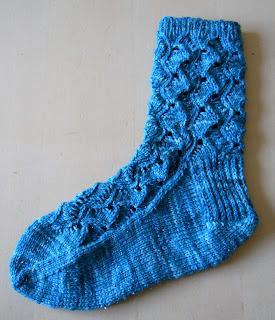Techniques: Blocking 1
One day S., a great knitter, came into the LYS where I teach desperate and disappointed. Her lace shawl she had just finished looked all crumbled up and shapeless. She told me that she came to show it to me before she frogs it or uses it as food for the wood stove.
Innocently I asked S. if she had already blocked it. She looked at me with this big question mark in her eyes. After I blocked her shawl S. was very surprised about the difference this made to the work she was ready to dump. The lace patterning showed, the shape came out fabulous, stitches evened out and it had a beautiful drape. We were both happy that her gorgeous work didn't end up feeding the wood stove or in a waste basket.....
Now they live happily ever after ;-)
This series about blocking will help you to find the right method for the fiber you were using in your knitting and give your work a great finished look.
Advantages of Blocking:
Innocently I asked S. if she had already blocked it. She looked at me with this big question mark in her eyes. After I blocked her shawl S. was very surprised about the difference this made to the work she was ready to dump. The lace patterning showed, the shape came out fabulous, stitches evened out and it had a beautiful drape. We were both happy that her gorgeous work didn't end up feeding the wood stove or in a waste basket.....
Now they live happily ever after ;-)
This series about blocking will help you to find the right method for the fiber you were using in your knitting and give your work a great finished look.
Advantages of Blocking:
- It sets the stitches and evens them out. A good way to fix little boo boo's.
- With edges unrolled and evened out, seaming will be much easier and pleasant.
- Lace and other pattern stitches will show better.
- The size of your piece can be adjusted to a certain extend.
- The drape or how the garment hangs will be much nicer.
- The color of hand-dyed yarn will look even more vibrant.
unblocked
blocked
The fiber I'm working with determines how I block it. Some of them can be weakened or destroyed if you use the wrong blocking method for them.
Therefore it's important to know a little bit more about the different kind of fibers which are out there and some quick facts which are important for blocking:
Animal (Protein) Fibers:
- Wool: The fiber can be bent over and over again without breaking and springs back to the original shape (good memory). Due to the overlapping scales on the surface the fiber will felt when the combination of heat, friction and moisture is applied. (The scales interlock and fuse)
- Mohair: Lightweight fiber from the angora goat has similar attributes as wool but is less resilient and weaker when wet.
- Alpaca and Llama: Long fiber from a Alpaca or Llama, which is has much less memory than wool and garments stretch and get out of shape easily when Alpaca is not blended with other fiber with more memory. Alpaca is very weak when wet.
- Cashmere: Fiber from the Cashmere Goat. Extraordinarily soft with similar attributes as wool when wet.
- Camel: Hair collected from Camels. Very strong fiber which is not very receptive to dye.
- Angora: The very short fiber comes from the Angora rabbit and is extremely soft, fluffy and warm.
- Qiviut: Fiber combed from Alaskan musk Ox which is 8 times warmer than wool and finer than Cashmere.
- Yak
- Silk: Silk has a protein structure even though it's not a hair. It is not resilient and will stretch easily if not blended with other fiber. Very fragile when wet.
Plant (Cellulose) Fibers :
- Cotton: Stronger when wet but much less elastic than wool and stretches out easily. The lack of resilience make flaws in knitting tension show.
- Linen: Fiber from the stem of the flax plant. Stronger when wet. softens through washing. Garments show wrinkles more easy.
- Ramie: Strong, linen like fiber with little resilience which washes well.
- Bamboo: Fiber from the bamboo plant. Lack of resilience makes the fabric stretchy and flaws in knitting tension show.
- Tencel: Man made fiber made from bleached wood pulp which has similar attributes as cotton. Heat can be applied.
- Rayon: Man made from cellulose obtained from cotton lint and wood chips. Heat can be applied. Bigger garments will stretch.
Man Made (Synthetic) Fiber:
- Polyamid, Nylon: Strongest textile fiber (therefore often used in sock yarn), durable, lightweight and elastic. Heat sensitive!
- Acrylic: Imitates wool but has a lack of insulation qualities. Heat sensitive!
- Polyester: Helps to make garments wrinkle resistant and holding the shape.
- Polypropylene: Has insulation qualities.
- Metallic Fibers: Heat sensitive!
Different blocking techniques for different fibers will be the content of the next post about blocking......




Comments